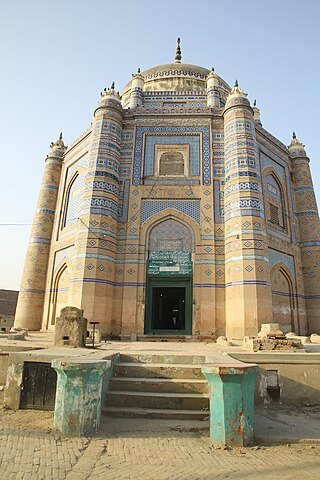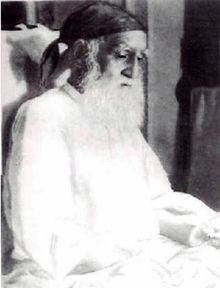
Multan is a city in Punjab, Pakistan, located on the bank of river Chenab. It is one of the five largest urban centres of Pakistan in 2024 and serves as the administrative centre of Multan Division. A major cultural, religious and economic centre of Punjab region, Multan is one of the oldest inhabited cities of Asia, with a history stretching deep into antiquity.

Makhdoom Yahiya Maneri was an Indian Sufi saint of the 13th century. His tomb in courtyard of a mosque, located in Maner, 29 km from Patna, Bihar, India.

Shaykh Syed Sharfuddin Bu Ali Shah Qalandar Panipati, renowned as Bu Ali Qalandar, born in Panipat, Delhi Sultanate, present-day Haryana, India, was a Qalandar and Sufi saint of the Owaisī Order, who lived and taught in India. His dargah (Shrine) is located in Panipat, and is a place of pilgrimage for his followers.

Baha-ud-din Zakariya, also spelled Bahauddin Zakariya, and also known as Baha-ul-Haq and Bahauddin Zakariya Multani, was a Sunni Muslim scholar saint and poet who established the Suhrawardiyya order of Baghdad in medieval South Asia, later becoming one of the most influential spiritual leaders of his era.
The city of Multan, Punjab, Pakistan has many mausoleums and shrines, due to its rich heritage of pirs and saints. Some of the best-known mausoleums that can still be visited today include the following.

The Tomb of Shah Ali Akbar is a tomb in Suraj Miani Multan, in Punjab province, Pakistan.

Pir Meher Ali Shah, was a Punjabi Sufi scholar and mystic poet from Punjab, British India. Belonging to the Chishti order, he is known as a Hanafi scholar who led the anti-Ahmadiyya movement. He wrote several books, most notably Saif e Chishtiyai, a polemical work criticizing the Ahmadiyya movement of Mirza Ghulam Ahmad.
Ghazi Salar Masud or Ghazi Miyan was a semi-legendary Muslim figure from India. By the 12th century, he had become reputed as a warrior, and his tomb (dargah) at Bahraich, Uttar Pradesh, India, had become a place of pilgrimage.
Satpanth is a Sanskrit term used initially by Nizari Isma'ilis and Ismaili Sufis to identify their faith formed over 700 years ago by Pir Sadardin. Although the term is today used mainly by its subgroup formed in the 15th century by his grandson Pir Imam Shah which itself consists of various sub-sects, and differs from the mainstream Nizari Khojas in that they reject the Aga Khan as their leader and are known more commonly as Imamshahi. Uniquely, the term Satpanth has been historically used by Ismaili, as well as by adherents of subgroups. There are villages in Gujarat which are totally Satpanthi such as Pirana near Ahmedabad where Imam Shah is buried. Satpanthi dargahs are known to be venerated with a stark contrast in the devotees, with outward Muslims who may wear a hijab, and outward Hindus wearing traditional garb such as the sari.

Sheikh Rukn-ud-Din Abul Fateh, commonly known by the title Shah Rukn-e-Alam, was an eminent 13th and 14th-century Punjabi Sufi saint from Multan, who belonged to Suhrawardiyya Sufi order. His shrine in Multan, is one of Punjab's most important places of historical and cultural value.

Sheikh Noor Ul Mashaikh Sayyid Ahmed Muhiyuddin Jeelani NooriShah Arabic:, known more commonly as NooriShah Jeelani, was a renowned 20th-century muslim, sufi, wali, mystic, orator, faqeeh, theologian, mujaddid and highly acclaimed Islamic scholar of the Qadri, Chisti order from the Indian sub continent. He was the 21st grand son of the famous Sufi saint Ghous-e-Azam Sheikh Mohiyudheen Abdul Qadir Jilani of Baghdad. He was also widely known by his title Noor-ul-Mashaikh. He was the Eponymous founder of the Silsila-e-Nooriya tariqa which is a sub-branch of Qadiriyya and Chistiyya in India.
Hajib Shakarbar was born as the younger of the two sons of Shams Tabrizi and Shams Sabzwari in 1213 AC. His grand parents named him Alauddin Muhammad, but when his father returned from Tabriz to see his newborn baby, he changed the name from Alauddin Muhammad to Syed Ahmad because he had a dream to this effect in Tabriz. The new baby showed the signs of a born Hafiz and so came to be known as Zinda Pir from his very infancy. He got the title of Shakarbar in Sabzwar and of Hajib in Makkah, and became so famous with the sweet combination of Hajib Shakarbar that his original names went into total oblivion. He joined his father in Multan, Pakistan, with his elder brother Naseeruddin, and a large armed escort of Turkish, Iraqi and Kabul fighters in 1289 AC.
Shah Qabool Aulia (1689–1767) was a Moroccan Muslim Sufi Pir who traveled through the Indian subcontinent preaching Islam.
Khwaja Habib Ali Shah was an Indian Sufi saint, whose lineage is traced back to Abu Bakr, the first Caliph of Islam.

ʿUthmān Sirāj ad-Dīn al-Bangālī , known affectionately by followers as Akhi Siraj, was a 14th-century Bengali Muslim scholar. He was a Sufi belonging to the Chishti Order and was a disciple of Nizamuddin Auliya of Delhi. As one of the senior disciples of Nizāmuddīn Auliyā, he spent long years with him in Delhi and earned the sobriquet of Āinā-e-Hind. His shrine, the Pirana Pir Dargah in Gaur, West Bengal, attracts hundreds of thousands of devotees every year. Siraj and his successor, Alaul Haq, are credited with the rise to prominence of the Chishti order in Bengal.

The Tomb of Shah Rukn-e-Alam located in Multan, Punjab, Pakistan, is the mausoleum of the 14th century Punjabi Sufi saint Sheikh Rukn-ud-Din Abul Fateh. The shrine is considered to be the earliest example of Tughluq architecture, and is one of the most impressive shrines in Asia. The shrine attracts over 100,000 pilgrims to the annual urs festival that commemorates his death.

Syed Baba Fakhr al-Din al-Hasani al-Hussaini commonly known as Baba Fakhruddin was a Persian Sufi of Suhrawardiyya order from present-day Eastern Iran.











